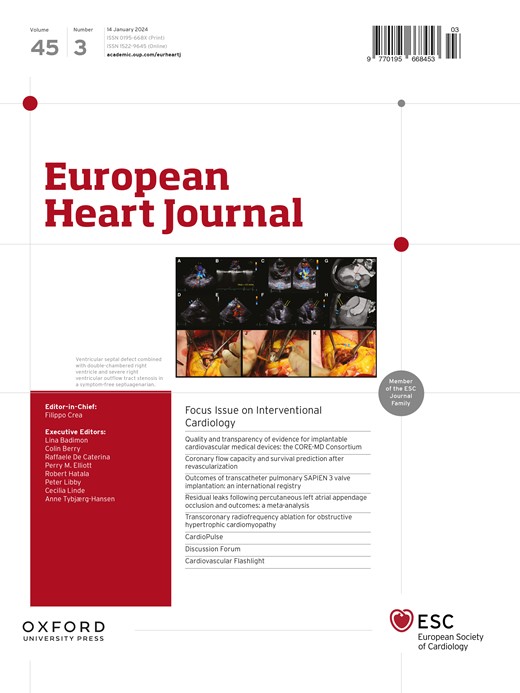动脉粥样硬化性肾血管性高血压的分流血流储备引导肾动脉支架术:FAIR随机试验。
IF 35.6
1区 医学
Q1 CARDIAC & CARDIOVASCULAR SYSTEMS
引用次数: 0
摘要
背景和目的:动脉粥样硬化性肾动脉狭窄(ARAS)患者的最佳治疗方法仍未解决。本研究比较了肾分流血流储备(FFR)引导下的血运重建术与传统血管造影引导下的血运重建术的疗效。方法共101例ARAS合并高血压患者随机分为ffr引导组和血管造影组(ClinicalTrials.gov标识号:NCT05732077)。无论FFR如何,血管造影引导组均行支架植入术,而FFR < 0.80的患者仅在FFR引导组行支架植入术。主要终点为3个月后日间动态平均收缩压(DMSBP)和抗高血压药物综合指数(CIAHM)的百分比变化。结果DMSBP (4% [-2%, 11%] vs . 4% [-3%, 10%], P = 0.97)和CIAHM (0% [0%, 3%] vs . 1% [0%, 4%], P = 0.33)在两组间无显著差异。然而,ffr引导组支架置入率明显较低(46.0% vs 100.0%, P < 0.01)。此外,与未接受支架植入的FFR≥0.80患者的结果相比,FFR < 0.80的患者支架植入是有益的(调整后平均DMSBP降低6.2[95%可信区间{CI}, 0.6-11.9] mmHg;平均CIAHM降低3.1 [95% CI, 1.5-4.7]),但FFR≥0.80的患者则不是(分别为1.4 [95% CI, -4.5-7.2] mmHg和0.7 [95% CI, -1.1-2.5])。结论与血管造影引导下的血管重建术相比,sffr引导下的血管重建术明显减少了不必要的支架植入术。在FFR < 0.80的患者中,支架置入术后血压和抗高血压药物使用均显著降低。本文章由计算机程序翻译,如有差异,请以英文原文为准。
Fractional flow reserve-guided renal artery stenting in atherosclerotic renovascular hypertension: the FAIR randomized trial.
BACKGROUND AND AIMS
The optimal therapy for patients with atherosclerotic renal artery stenosis (ARAS) remains unresolved. This study compared the efficacy of renal fractional flow reserve (FFR)-guided revascularization and traditional angiography-guided revascularization.
METHODS
In total, 101 patients with ARAS and hypertension were randomly assigned to either the FFR-guided or angiography-guided group (ClinicalTrials.gov identifier: NCT05732077). Stenting was performed in the angiography-guided group regardless of FFR, whereas stenting was only performed in the FFR-guided group for patients with FFR < 0.80. The primary endpoints were the percentage changes in ambulatory daytime mean systolic blood pressure (DMSBP) and composite index of antihypertensive medicines (CIAHM) after 3 months.
RESULTS
The percentage changes in DMSBP (4% [-2%, 11%] vs 4% [-3%, 10%]; P = .97) and CIAHM (0% [0%, 3%] vs 1% [0%, 4%]; P = .33) did not differ between groups. However, the rate of stenting was significantly lower in the FFR-guided group (46.0% vs 100.0%, P < .01). Moreover, compared with the findings in patients with FFR ≥ 0.80 who did not receive stenting, stenting was beneficial in patients with FFR < 0.80 (adjusted mean DMSBP reduction, 6.2 [95% confidence interval {CI}, 0.6-11.9] mmHg; mean CIAHM reduction, 3.1 [95% CI, 1.5-4.7]), but not in those with FFR ≥ 0.80 (1.4 [95% CI, -4.5-7.2] mmHg, and 0.7 [95% CI, -1.1-2.5], respectively).
CONCLUSIONS
FFR-guided revascularization significantly reduced unnecessary stenting compared with angiography-guided revascularization. Both blood pressure and antihypertensive medication usage decreased significantly after stenting in patients with FFR < 0.80.
求助全文
通过发布文献求助,成功后即可免费获取论文全文。
去求助
来源期刊

European Heart Journal
医学-心血管系统
CiteScore
39.30
自引率
6.90%
发文量
3942
审稿时长
1 months
期刊介绍:
The European Heart Journal is a renowned international journal that focuses on cardiovascular medicine. It is published weekly and is the official journal of the European Society of Cardiology. This peer-reviewed journal is committed to publishing high-quality clinical and scientific material pertaining to all aspects of cardiovascular medicine. It covers a diverse range of topics including research findings, technical evaluations, and reviews. Moreover, the journal serves as a platform for the exchange of information and discussions on various aspects of cardiovascular medicine, including educational matters.
In addition to original papers on cardiovascular medicine and surgery, the European Heart Journal also presents reviews, clinical perspectives, ESC Guidelines, and editorial articles that highlight recent advancements in cardiology. Additionally, the journal actively encourages readers to share their thoughts and opinions through correspondence.
 求助内容:
求助内容: 应助结果提醒方式:
应助结果提醒方式:


